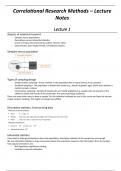Class notes
Lecture Notes Correlational Research Methods (424527-B-5)
- Course
- Institution
This includes all lecture notes from lecture 1 until 12. I used the formula function in word which causes the notes to be very clear and useful in studying. Good luck!!
[Show more]



